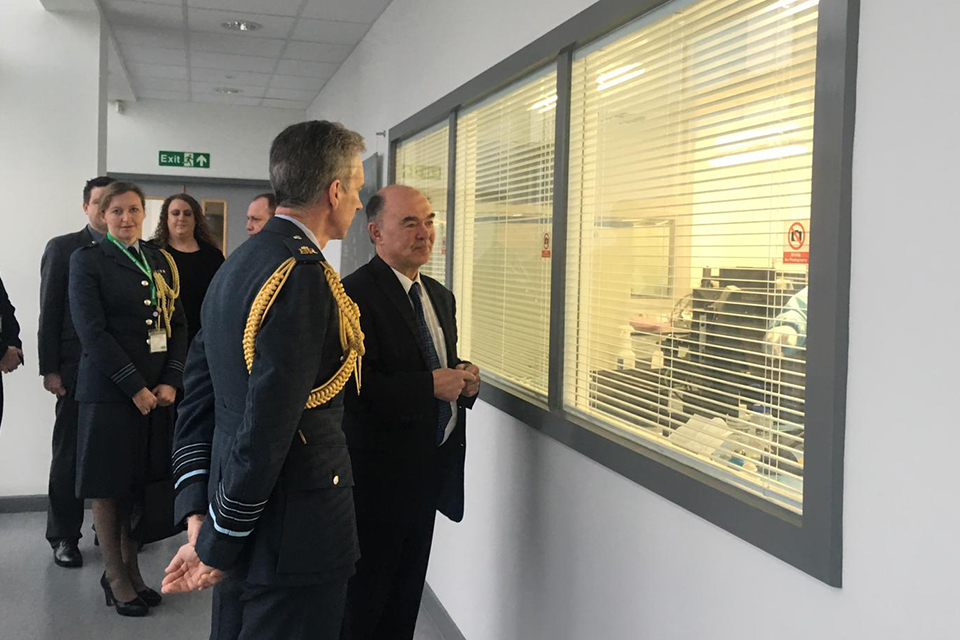The third to be named in the City Class of eight brand new, cutting-edge, anti-submarine warfare frigates, HMS Cardiff will provide advanced protection for the likes of the UK’s nuclear deterrent and Queen Elizabeth Class aircraft carriers, and offer an unrivalled anti-submarine warfare capability.
Defence Secretary Gavin Williamson said:
HMS Cardiff will be a terrific tribute to Wales and its capital city. She will bolster the United Kingdom’s defences across the seven seas – protecting our aircraft carriers and defending our waters from intensifying threats.
First Sea Lord Admiral Sir Philip Jones said:
It’s great to see the name HMS Cardiff returning to the Fleet as one of our new Type 26 Frigates, reflecting the Royal Navy’s long-standing bond with the city and the people of Wales. The name HMS Cardiff brings with it a proud history. A century ago the light cruiser HMS Cardiff famously led the German High Seas Fleet into internment at Scapa Flow at the end of the First World War. The last HMS Cardiff, a Type 42 destroyer, also distinguished herself on operations around the world, including the 1982 Falklands campaign, the 1991 Gulf War and service in the Adriatic during the 1999 crisis in Kosovo.
This next generation of frigates will encompass the very latest innovations and technological advances to deliver a world class anti-submarine warfare capability within a globally deployable and highly versatile platform. For years to come, as part of a Royal Navy carrier-led task group or working with our international partners, HMS Cardiff and her sister ships will be ready to deliver a wide spectrum of operations from diplomatic and humanitarian missions to high end warfighting, promoting and protecting Britain’s interests worldwide.
The naming was marked by an event at Mansion House in Cardiff this morning, led by students from the Welsh University Royal Naval Unit. The training establishment for a group of undergraduates from across the nation who show potential as future leaders of society.
Welcoming the news, Defence Minister Guto Bebb said:
As a proud Welshman, it is a great honour to herald another era of a warship with the name HMS Cardiff protecting the UK at home and abroad. These students have shown great passion for everything the Royal Navy stands for, and if they do go on to be captains of the future, they could be at the helm of a truly formidable, cutting-edge warship in HMS Cardiff.
The new HMS Cardiff is set to enter service in the 2020s and, along with her fellow Type 26 frigates, will deliver high-end warfighting wherever it is needed, whilst protecting the UK’s interests as well as Britain’s nuclear submarines. Its flexible design will also enable these capabilities to be adapted to counter future threats, and the ships will benefit from the latest advances in digital technology.
She will be the fourth ship to be named in honour of the Welsh capital city, and the announcement comes 100 years after the first HMS Cardiff led the surrendered German High Seas Fleet into Scapa Flow at the end of the First World War.
The St. David’s Day announcement is a further example of Defence’s commitment to Wales, where the MOD has today announced it spends £300 for every member of the population, £20 more per person than last year. The work being done in Wales includes the UK’s biggest single order for an armoured vehicle in 30 years: the £4.5bn Ajax vehicles being built at General Dynamics’ Merthyr Tydfil factory.
Also, this years’ Armed Forces Day will be held in Wales, on the 30 June in the historic North Wales seaside town of Llandudno. The event, which will also mark Armed Forces Day’s tenth birthday, will celebrate the work of our servicemen and women with a spectacular military parade, fly pasts and impressive displays of equipment.
North Wales has many current and historic links to the Armed Forces, including many Regular and Reserve Army units. Many North Walians are proud to serve in the Royal Welsh and nearby RAF Valley on Anglesey is home to a fast jet training base. Nearly 10,000 veterans live in Conwy, supported by a number of local and national charities.
The announcement also comes as BAE Systems have awarded Lockheed Martin a contract to equip the Type 26 with the only system of its kind capable of launching anti-air, anti-submarine, surface-to-surface and strike-length missiles. Three MK 41 Vertical Launching Systems will be fitted on each ship. The Royal Navy has ordered an initial nine modules for the first three ships, including HMS Cardiff.
A number of close allies, including Australia and Canada, are also considering the state-of-the-art Type 26 design. HMS Sutherland is currently in Australia demonstrating the UK’s world-class anti-submarine capability.
The Royal Navy’s Type 26 frigates are being built at the Clyde shipyards in Scotland. The MOD announced an unprecedented 20 years of work there in 2017, safeguarding over 4,000 jobs, with the £3.7bn contract for the first three of eight submarine hunting Type 26 frigates to be built there. Two other ships in the class have already been named HMS Glasgow and HMS Belfast. HMS Cardiff is the third ship to be named and will be the second to enter production.
Secretary of State for Wales Alun Cairns said:
This is a very proud moment not only for the Royal Navy but for the whole of Wales.
Wales has a strong military footprint, and this announcement is a celebration of the contribution our nation makes to the defence of the UK.
I’m proud to see the name of our capital city on a Royal Navy warship that will take to international waters to defend our national security and protect our servicemen and women around the world.
